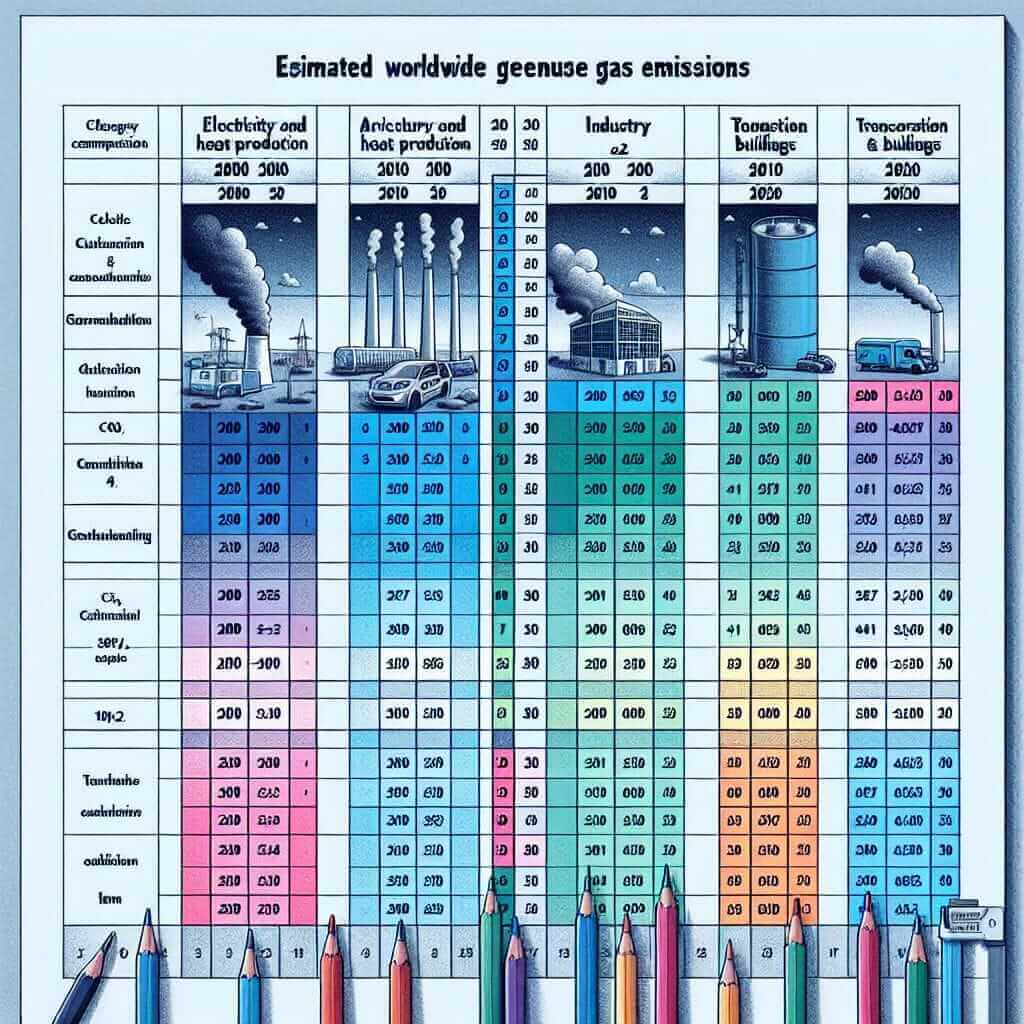The IELTS writing task 1 often features topics of global significance, and “Greenhouse Gas Emissions by Sector” is a prime example. This topic area is frequently tested, highlighting the importance of understanding environmental issues and data interpretation for the IELTS exam.
To help you ace this section, let’s explore potential IELTS Writing Task 1 questions related to this critical issue:
- The pie charts below show the greenhouse gas emissions by sector in the UK in 2000 and 2020.
- The table illustrates the changes in greenhouse gas emissions from different sectors globally between 2000 and 2020.
- The line graph compares the trends in greenhouse gas emissions from the energy and transportation sectors worldwide from 2000 to 2023.
Sample IELTS Writing Task 1 Question and Model Answer
Let’s delve into a sample question and craft a model answer that exemplifies the qualities of a Band 8+ response.
Question:
The table below shows the estimated global greenhouse gas emissions (in gigatonnes of CO2 equivalent) from five different sectors in the years 2000, 2010, and 2020.
| Sector | 2000 | 2010 | 2020 |
|---|---|---|---|
| Electricity and Heat Production | 12.0 | 15.5 | 16.8 |
| Agriculture, Forestry & Other Land Use | 11.2 | 12.5 | 13.1 |
| Industry | 8.5 | 10.2 | 11.7 |
| Transportation | 6.8 | 8.1 | 9.5 |
| Buildings | 5.2 | 6.0 | 6.9 |
Summarize the information by selecting and reporting the main features and making comparisons where relevant.
Write at least 150 words.

Model Answer:
The table provides an overview of the estimated global greenhouse gas emissions from five key sectors over two decades, from 2000 to 2020. Overall, emissions have seen an upward trend across all sectors, with electricity and heat production remaining the most significant contributor.
In 2000, the electricity and heat production sector was responsible for the largest share of emissions, releasing 12 gigatonnes of CO2 equivalent. This figure increased to 15.5 gigatonnes in 2010 and further to 16.8 gigatonnes in 2020, solidifying its position as the top emitter. Agriculture, forestry, and other land use constituted the second largest source, albeit with a less pronounced increase from 11.2 gigatonnes to 13.1 gigatonnes over the twenty-year period.
Similarly, emissions from the industry sector exhibited a steady rise, reaching 11.7 gigatonnes in 2020 compared to 8.5 gigatonnes in 2000. The transportation and buildings sectors followed a similar pattern of growth, though their overall contributions were lower than the other three sectors throughout the period under review.
Word count: 159 words
Key Points for Writing About Greenhouse Gas Emissions
Vocabulary Essentials:
- Greenhouse gas emissions: Gases that trap heat in the Earth’s atmosphere, contributing to global warming (e.g., carbon dioxide, methane, nitrous oxide).
- Sectors: Distinct parts or branches of an economy or activity (e.g., energy, agriculture, industry).
- Gigatonne (Gt): A unit of measurement equal to one billion metric tons.
- CO2 equivalent: A standardized unit for measuring the global warming potential of different greenhouse gases.
- Trends: General directions of change or development over time (e.g., upward, downward, fluctuating).
Grammar Tips:
- Use the present tense when describing data in a table unless the data refers to the past.
- Practice using comparative and superlative adjectives to highlight differences and similarities between sectors and time periods.
- Be mindful of subject-verb agreement, especially when using complex sentence structures.
- Utilize a variety of grammatical structures to enhance the overall sophistication of your writing.
IELTS Writing Strategies:
- Paraphrase the question: Rephrase the question prompt in your own words to demonstrate comprehension.
- Highlight key features: Focus on the most significant trends and differences in the data.
- Use data to support your statements: Provide specific figures from the table to justify your observations.
- Maintain a formal and objective tone: Avoid personal opinions or subjective interpretations.
- Proofread carefully: Allocate time to review for any grammatical or spelling errors.
Challenging Vocabulary for Advanced Learners:
- Anthropogenic (adj.) /ˌæn.θrə.pəˈdʒen.ɪk/: Originating from human activity. Example: Anthropogenic greenhouse gas emissions are the primary driver of climate change.
- Deforestation (n.) /ˌdiːˌfɔr.ɪˈsteɪ.ʃən/: The clearing of forests for other land uses. Example: Deforestation is a significant contributor to rising carbon dioxide levels.
- Mitigation (n.) /ˌmɪt.ɪˈɡeɪ.ʃən/: Actions taken to reduce the severity or impact of something. Example: Climate change mitigation strategies aim to reduce greenhouse gas emissions.
- Renewable energy (n.) /rɪˈnuː.ə.bəl ˈen.ə.dʒi/: Energy from sources that are naturally replenished, such as solar, wind, and hydropower. Example: A transition to renewable energy sources is crucial for reducing our reliance on fossil fuels.
- Carbon sequestration (n.) /ˈkɑːr.bən ˌsiː.kwəˈstreɪ.ʃən/: The process of capturing and storing atmospheric carbon dioxide. Example: Forests play a vital role in carbon sequestration, absorbing CO2 from the atmosphere.
Conclusion
Mastering the art of analyzing and writing about data, particularly on pressing issues like greenhouse gas emissions, is essential for achieving a high band score in IELTS Writing Task 1. By familiarizing yourself with relevant vocabulary, grammar rules, and effective writing strategies, you can confidently tackle this task and demonstrate your English language proficiency. Remember to practice regularly using authentic IELTS materials and seek feedback to refine your skills further.